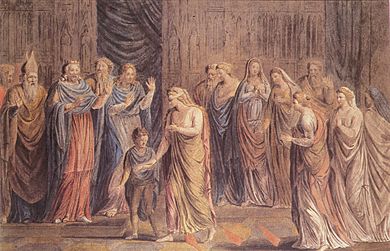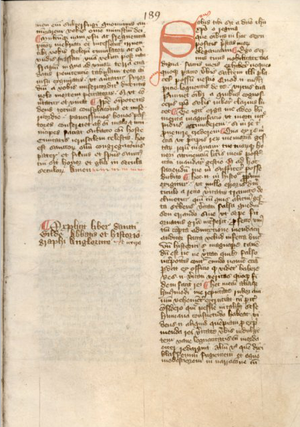Emma of Normandy facts for kids
Quick facts for kids Emma of Normandy |
|
|---|---|

|
|
| Queen consort of the English | |
| Tenure |
|
| Queen consort of Denmark | |
| Tenure | 1018 – 12 November 1035 |
| Queen consort of Norway | |
| Tenure | 1028 – 12 November 1035 |
| Born | c. 984 Normandy, France |
| Died | 6 March 1052 (aged c. 68) Winchester, Hampshire, England |
| Burial | Old Minster, Winchester. Bones now in Winchester Cathedral |
| Spouse |
|
| Issue | |
| House | Normandy |
| Father | Richard the Fearless |
| Mother | Gunnor |
Emma of Normandy (also known as Ælfgifu; c. 984 – 6 March 1052) was a powerful noblewoman from Normandy, France. She became a queen in three different countries: England, Denmark, and Norway.
Emma was the daughter of Richard the Fearless, a ruler of Normandy. She married two important kings: first, Æthelred the Unready of England, and later, Cnut the Great, who ruled England, Denmark, and Norway. Emma was Queen of England from 1002 to 1016 with Æthelred. After he died, she married Cnut in 1017. She was Queen of England, Denmark, and Norway until Cnut's death in 1035.
After Cnut died, Emma stayed involved in politics. She helped her sons, Edward the Confessor and Harthacnut, rule. Emma is a key figure in a special book called the Encomium Emmae Reginae. This book tells us a lot about English politics in the early 1000s.
Contents
Emma's First Marriage: To King Æthelred II
Becoming Queen of England
In 1002, Emma married Æthelred of England. This marriage was a way to make peace between England and Normandy. It also aimed to stop Viking raids on England, which often came from Normandy.
When she married, Emma was given the Anglo-Saxon name Ælfgifu. She became the Queen of England. She also received her own lands in places like Winchester and Exeter.
Children and Exile
Emma and King Æthelred had three children:
- Edward the Confessor
- Alfred Ætheling
- Goda of England (also called Godgifu)
In 1013, Sweyn Forkbeard, a Danish king, invaded and took over England. Emma and her children had to flee to Normandy. King Æthelred joined them later. They all returned to England after Sweyn died in 1014.
Succession Challenges
King Æthelred died in 1016. His oldest son from his first marriage, Æthelstan, had already died. This meant Emma's sons were not first in line for the throne. Æthelred's third son, Edmund Ironside, became the main heir.
Emma tried to get her son, Edward, recognized as the next king. But Edmund Ironside and his supporters opposed this.
Emma's Second Marriage: To King Cnut
Cnut's Rise to Power
In 1015, Cnut, Sweyn Forkbeard's son, invaded England. He fought against Edmund Ironside. Cnut won the Battle of Assandun in 1016. They agreed to divide England, but Edmund died soon after. Cnut then became the king of all England.

In 1017, Emma married Cnut. This marriage helped Emma keep her position and may have saved her sons' lives. After the marriage, Emma's sons from Æthelred were sent to live in Normandy. Emma became Queen of England. Later, she also became Queen of Denmark and Norway when Cnut conquered those lands.
Family with Cnut
Emma and Cnut had two children:
Some historical writings suggest that Emma and Cnut's marriage, which started for political reasons, grew into a loving relationship.
Challenges After Cnut's Death
The Death of Alfred
After Cnut died in 1035, Emma's son Harthacnut became king. However, Harthacnut was in Denmark. Emma was chosen to rule England until he returned.
In 1036, Emma's sons from Æthelred, Alfred Ætheling and Edward the Confessor, came back to England from Normandy. They were supposed to be safe under Harthacnut's protection. But Alfred was captured and blinded. He later died from his injuries.
Edward managed to escape and went back to Normandy. He returned later when his claim to the throne was more secure. Some people believe Harold Harefoot was responsible for Alfred's death. Others think it might have been Godwin, Earl of Wessex.
Harthacnut's Reign
Harthacnut came to England in 1040 and became king. He was criticized for taxing people heavily to pay for his fleet. He also had Harold Harefoot's body dug up and thrown away.
In 1041, Harthacnut invited his half-brother, Edward the Confessor, to England. It is believed that Edward was recognized as the next king. Emma likely encouraged this to make sure one of her sons would still rule England.
Edward's Reign and Emma's Later Life
After Harthacnut died in 1042, Edward the Confessor became king. He was crowned in 1043.
Later that year, King Edward accused Emma of treason and took away her lands and titles. However, he soon changed his mind. Emma's lands and titles were given back to her.
Emma's Importance as Queen
Emma was one of the first queens in the early Middle Ages to have her portrait painted. The Encomium Emmae Reginae is a very important book about her. It helps us understand who would become king in England in the 1000s.
When Emma was married to Æthelred, she was mostly a symbol of the peace treaty between England and Normandy. But her power grew a lot when she married Cnut. She became one of the richest women in England. She also had a lot of influence over the church in England.
The Encomium Emmae Reginae
The Encomium is a book written to praise Emma. It has three parts:
- The first part talks about Sweyn Forkbeard and his conquest of England.
- The second part focuses on Cnut. It describes his victory over Æthelred and Edmund, his marriage to Emma, and his time as king. It doesn't mention Emma was Æthelred's wife before.
- The third part covers events after Cnut's death, including Emma's role in taking the royal treasury and the actions of Earl Godwin.
Historians believe this book was written to help Emma's political goals. It was a way to show her importance and influence at court.
Old Manuscripts
For a long time, people thought there was only one copy of the Encomium. But in 2008, another copy was found in England. This new copy is from the late 1300s and is now kept in Denmark.
Another old book, the New Minster Liber Vitae, shows a picture of King Cnut and Queen Emma. They are shown giving a cross to an altar. This picture shows Emma as both a loyal wife and a powerful queen.
The Legend of Queen Emma's Ordeal

There is a famous legend about Queen Emma called "The Ordeal of Queen Emma by Fire." This story probably started in the 1200s.
According to the legend, Emma was accused of being unfaithful with a bishop. To prove she was innocent, she had to walk over nine red-hot ploughshares (parts of a plow) in Winchester Cathedral. The story says that she walked over them without feeling any pain or heat. She had prayed to St Swithun, a saint whose shrine is in Winchester. This legend shows how people viewed Emma as a strong and pure queen.
Family tree
|
|||||||||||||||||||||||||||||||||||||||||||||||||||||||||||||||||||||||||||||||||||||||||||||||||||||||||||||||||||||||||||||||||||||||||||||||||||||||||||||||||||||||||||||||||||||||||||||||||||||||||||||||||||||||||||||||||||||||||||||||||||||||||||||||||||||||||||||||||||||||||||||||||||||||||||||||||||||||||||||||||||||||||||||||||||||||||||||||||||||||||||||||||||||||||||||||||||||||||||||||||||||||||||||||||||||||||||||||||||||||||||||||||||||||||||||||||||||||||||||||||||||||||||||||||||||||||||||||||||||||||||||||||||||||||||||||||||||||||||||||||||||||||||||||||||||||||||||||||||||||||||||||||||||||||||||||||||||||||||||||||||||||||||||||||||||||||||||||||||||||||||||||||||||||||||||||||||||||||||||||||||||||||||||||||||||||||||||||||||||||||||||||||||||||||||||||||||||||||||||||||||||||||||||||||||||||||||||||||||||||||||||||||||||||||||||||||||||||||||||||||||||||||||||||||||||||||||||||||||||||||||||||||||||||||||||||||||||||||||||||||||||||||||||||||||||||||||||||||||||||
Images for kids
-
Queen Emma and her sons being received by Duke Richard II of Normandy.
-
A mortuary chest from Winchester Cathedral. It is believed to hold the bones of Cnut and Emma.




